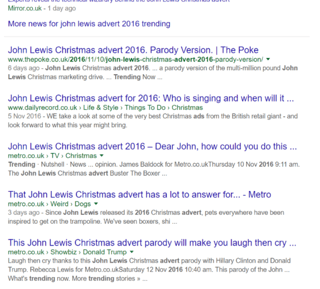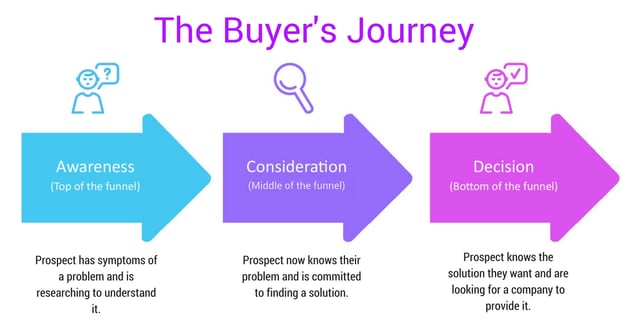Don't leave it any longer, now is the time to start planning an inbound marketing strategy to make sure you get ahead of the competition in 2020.

* Blog updated 25/06/2019 *
Effective Traditional Ad Campaigns Take Lots Of Forward Planning - But The Best Inbound Campaigns Last A Lot Longer
Whilst certain traditional ad campaigns generate huge hype and discussion, this is short lived. Especially when compared with the preparation and planning that goes into them.
In contrast, inbound campaigns compound their effectiveness and get better over time. They just need an element of front end work too.
Below is a discussion on how even the hugely popular John Lewis Christmas ad shows traditional advertising is largely ineffective, yet inbound marketing is cheaper and longer lasting. If you are ready to start your own inbound marketing campaigns, try our free starter pack and make sure 2020 is a marketing success.
This blog is quite lengthy and is broken into the following sections. If you would like to jump straight to a particular section, just click on the subtitle in the bullets below and you can go straight there:
- The John Lewis Ad Shows How Traditional Advertising Is Actually Ineffective
- On The Other Hand, Inbound Has A Lasting Effect
- What Inbound Marketing Is
- The Buyer's Journey Diagram
- But You Need To Start Planning Your 2018 Marketing Strategy Now
- The Work And Timescales Involved In Planning An Inbound Campaign
- A Lot To Do
- Already Conducting Your Own Inbound Campaigns But Want Better Results?
The John Lewis Ad Shows How Traditional Advertising Is Actually Ineffective
Before you know it, once the pumpkin has been thrown in the wheelie bin, every advert and promotional offer is geared towards getting us to spend our money with a particular retailer in the Christmas period. With a yearly increase in anticipation and hype, the Christmas season is deemed to be underway as soon as John Lewis unveil their Christmas TV ad.
It's greeted with much love and disappointment (false and genuine) all over social media. And it also inspires a wealth of content as it becomes the hot topic upon release; parodies, reviews, round-ups and in-depth comparisons to M&S and other retailers' efforts.

"John Lewis Christmas Ad" SERP.
But sticking with the leading advert itself, for the moment, it's a great example of the foresight and meticulous planning that goes into such a far reaching and publicity generating campaign.
The days after the premiere of #BusterTheBoxer saw lots of sharing, online and face-to-face chat about the ad and the John Lewis brand as a whole.
That was down to the months and months of planning and development involved in putting together a fully coherent campaign. A highly detailed and coordinated campaign which features, amongst other things: a VR experience at the flagship John Lewis store in London and £12 cuddly toys of the animals featured in the ad being on sale across the country (including 10% of profits being donated to The Wildlife Trust).
As great as all that is, how many people in your office are still talking about the ad? Let alone shopping at John Lewis?
And this isn't, of course, any kind of comment against the agency who worked on the John Lewis campaign. It's a heartwarming campaign which most people enjoy.
But it's an example of the lengths that traditional advertisers now need to go to in order to make a worthwhile impact.
On The Other Hand, Inbound Has A Lasting Effect
Whilst the John Lewis brand undoubtedly benefits from this type of promotion, otherwise they wouldn't go to such expense every year, the content itself is short lived. And this level of advertising is only accessible for big, big businesses with big, big budgets.
For the rest of us, we need to choose our marketing battles more carefully. And this is where inbound marketing comes into its own.
The reason that a traditional marketing campaign doesn't have long lasting results or wide-reaching impact, without such massive expense, preparation, and (not to forget) existing brand awareness, is because today's audiences are attuned to ignoring and disengaging with traditional outbound advertising.
Since the advent of online advertising and the deluge spam and ad-blocking software that came with it, and the ability to fast forward TV adverts, as well as a whole host of other technological advances - traditional, interruptive advertising has become largely ineffective.
Today's market prefers to research their own free solutions to problems, read reviews about companies before choosing to pay to use their services and only want to access information about a company on their own terms.
This is down to improved search engine software and mobile technology. And that is why inbound marketing is crucial to making sure that your business is primed to be in the mix when consumers, who are annoyed with and are ignoring traditional advertising, turn to the internet to find helpful blogs, videos and free guides.
What Inbound Marketing Is
Inbound marketing starts with researching who your buyer persona is.
This isn't an ideal target market, but a rounded and well researched, fictional type of person, of who you understand the struggles and desires, their internet browsing habits and research methods, and, most importantly, how to resonate and speak to them.
You can then begin producing free content, which they can use during their researching to find out more about the problem they are experiencing.
As their problem develops and your free advice hasn't quite been enough to resolve the issue they're facing, they might return to your website to get more free advice. The more in-depth information they need would be included in something like a free eBook, which they can open by entering their name and email address into a form.
You have now helped them for free twice and helped them figuratively patch up a resolution to their problem. But the time has come for them to purchase a full and proper paid resolution.
When they reach the point where it's time to choose a supplier, known as the decision phase of what is called the Buyer's Journey, instead of hoping they have seen and remember your TV ad (did you remember to head to John Lewis whilst out Christmas shopping?) or hoping your PPC bids and copy are strong enough to get you clicked on in the SERP, you have already been reaching out to them via email since they downloaded your free eBook. And software such as HubSpot can do this autonomously.
The inbound process nurtures visitors into becoming a contact by offering premium quality free content. You can then market to them via email and nurture them into becoming a lead who is ready to speak to your sales team.
That is a friendly, helpful and informative way of nurturing a person along the Buyer's Journey, based on trust and openness. Instead of using mass marketing techniques - traditional, outbound advertising - and hoping your ad appears at the right time.
When it comes to a consumer choosing a supplier, they will already have invested time and energy into your business, so are more likely to purchase your services or product.

But You Need To Start Planning Your 2020 Marketing Strategy Now
Just as traditional outbound advertising campaigns take time and proper planning, so do inbound campaigns. For Search Engine Optimisation (SEO) to take effect and your content to start being found regularly by internet users typically takes up to 6 months to reach peak levels.
That isn't to say inbound marketing doesn't bring and leads until that point, it just, roughly speaking, takes that long to reach peak performance. But from then, that peak performance is maintained or bettered once your authority grows.
The beauty of using inbound marketing techniques is that the content and email marketing (as well as complimentary SEO and PPC) can be sharpened and honed continuously, as you go forward. And your content exists out in the ether for as long as you have your site and blog. It won't be gone and forgotten about when the next trending topic on Twitter arrives or a competitor launches their own TV ad campaign (John Lewis is looking at you, Waitrose and M&S).
For the traffic to start arriving and your content to rise up the SERPs takes planning and it takes time. You need to research your Buyer Personas, their respective Buyer's Journeys and create the content that you are going to offer them.
If you want to start seeing inbound results in 2020, you should be starting your campaigns in Q4 of 2019.
The Work And Timescales Involved In Planning An Inbound Campaign
Whilst it might take up to 6 months for inbound content to reach peak traffic levels and convert enough visitors into becoming contacts who can be nurtured into leads, there is vital work to be done prior to putting your inbound content live.
If you want to hit the ground running with an effective inbound strategy in 2020 and steal a march on the competition, it's best to start in November 2019. For your inbound marketing to be fully effective, there is all of the following to consider and complete.
Step 1: SEO Groundwork & Research - November 2019
There needs to be a lot of SEO groundwork, internal auditing and administration completed.
This is the equivalent of starting the construction of a new house on a potential flood plain by lowering the water table and drying out the surrounding sub-soil by improving the natural drainage. Without that prior work, you could build the world's greatest foundations and footings, but they'd still come unstuck once the earth below became saturated over time.
Taking the time to complete the following initial elements is vital to an effective inbound campaign which will be launched in the New Year:
- SEO Keyword Research - as this will underpin and shape all your content and copy at a later stage.
- Technical SEO Audit - to find any harmful or under performing aspects which currently exist.
- Fix SEO Issues - so that ranking changes can take effect by the time the campaign launches.
- Design Landing Page Templates - because they will need reviewing and sharpening as your Personas and content takes shape.
- Design and Implement a Blog - in order to have a place to publish content.
- Setup Your Marketing CRM - so that you can be familiar with the software and have everything in place to enable automated marketing as soon as possible.
- Organise and Segment Your Contact Database - so that you can market to leads differently depending on where they are in their lifecycle and Buyer's Journey.
- Research and Create Buyer Personas - so you can craft and shape content that they will search out.
- Document Buyer's Journeys - so you can produce content that will interest a user at every step in the journey.
- Carry Out an Existing Content Audit - to see what can be repurposed and recycled. And what needs improving further.
- Setup Social Media Accounts - as this is the place you will often promote your content and reach new users and it takes time to grow a following.
Step 2: Planning & Writing Content - December 2019
With the prior work in place, it's time to start planning and crafting your first six month campaign in order to get ready for launch. All of the automated content which nurtures leads through the Buyer's Journey needs to be pre-written. And, of course, the content which attracts visitors in the first place needs to be written too.
Here's a run down of what's involved at this stage when making a six month campaign:
- Specific Blog Keyword Research - beyond general on-page keywords, campaign and blog specific keywords need to be found.
- Blog Topics and Title Planning - that will be understood by search engine crawls and impress would be readers at the same time.
- Email Topics and Titles - that are on message and will get opened and actioned.
- Key Social Media Dates - so that you can plan when to target and avoid posting.
- Content Plan Based On This Audit - so that all parts of the process are working in harmony.
You also need to set up your automated email campaign, which involves:
- Planning A Workflow - in order to organise effective sending times, how to segment contacts based on their interaction with preceding emails and information you learn about them.
- Write and Design the Emails - so that, once they're opened, they nurture contacts into leads and then onto being ready to become a conversion.
- Test Fully - by experiencing every aspect of the workflow in real time so that you can sharpen and tweak it as much as possible.
And, finally for this stage, you will also need to conduct further on-page SEO optimisation in line with your first campaign and the ongoing keyword research generally. This is a live process which needs close management due to all of the moving parts involved: search engine changes, user habits evolving, competitor actions, contextual changes... to name just a few.
Step 3: Creating Premium Content & Going Live - January 2020
Whilst you have been planning your general content and starting to get it written, you also need to be producing your download content that will entice visitors into becoming contacts. Creating this has more associated work than just the content itself:
- Write The Body Copy - which is useful and informative, beyond the level on your blog, but also just in depth enough to leave a reader/user wanting more from you.
- Design - so that it looks better than anything else available, appeals to your persona and helps move them along their Buyer's Journey.
- Create Effective CTAs - Call-To-Actions which will encourage visitors to head to your landing pages.
- Create A Landing Page - based on your earlier draft design and that is highly optimised to convert those who end up seeing it.
- Upload and Implement - and monitor performance.
- Test and Amend - continuously so that everything is 100% optimised.
At the same time, it is time to start putting those previously written blogs live, share them on social media, keep writing new content and sharing that too. Whilst also conducting off-page SEO improvements.
A Lot To Do
As you can see, there is a lot of work to get done in order to make sure your 2020 inbound marketing campaign is actually underway in the New Year. If you wait until January to start this process, it will be March, at the earliest, before anything starts going live and contacts can start coming in. Then it will be getting into September before the content in that campaign reaches peak traffic levels.
Before you know it, the next John Lewis ad will be only a couple of weeks away.
Start planning now means that, at this point next year, you will have two full inbound campaigns worth of content gathering contacts and leads for you, whilst you will have different workflows and emails busy nurturing leads on your behalf. And you can start to plan for yet more growth over the coming year.
Are you ready to start your own Inbound Marketing Campaign?
Try our free starter pack and make sure 2020 is a marketing success! Our pack includes 5 free inbound marketing templates that contains everything you need to: understand your personas, spot gaps in your content, align your sales and marketing funnel, and plan/execute successful email automation.
Real Growth. Real Impact.
'Should I use HubSpot?' 32 fundamental reasons why you should
21 cost-effective marketing campaigns you can create right now
Breeze: Everything you need to know about HubSpot's powerful AI
INBOUND 24 learnings and updates
Google Search API leaks: All you need to know [LIVE BLOG]
The top 6 marketing challenges of 2024
Inbound vs outbound marketing: What's the difference?
See why enterprises choose Avidly
Let’s build your HubSpot success story
Compelling final call to action - with accompanying link to Contact page





![Google Search API leaks: All you need to know [LIVE BLOG]](https://www.avidlyagency.com/hs-fs/hubfs/cloud.jpg?width=400&height=225&name=cloud.jpg)


